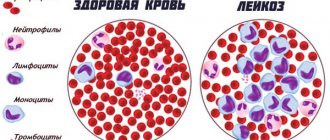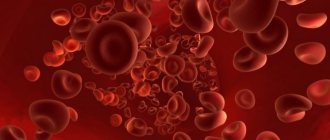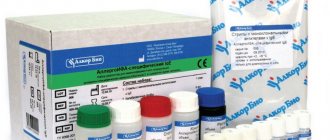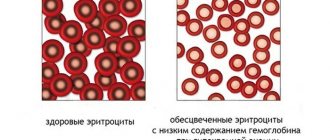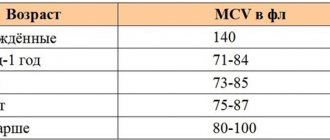- Causes of Leukemia
- Why is leukemia dangerous?
- Types of blood cancer
- Signs and symptoms of leukemia
- Stages of blood cancer
- Diagnosis of leukemia
- Treatment methods
- Forecast
- Leukemia Treatment Clinics
Blood cancer (leukemia, leukemia) is a malignant degeneration of hematopoietic cells in the bone marrow.
In this condition, damaged, immature cells accumulate in the blood and organs of the body. They are not able to perform the normal functions of blood cells, but at the same time they replace them. As a result, the blood becomes unable to carry oxygen and perform its immune functions. More than 300,000 people are diagnosed with leukemia every year. The risk of developing leukemia increases with age, but the disease can also develop in people under 20 years of age.
What is blood cancer?
Usually this is a combination of various pathologies, due to which the hematopoietic system is completely suppressed, and as a result, healthy bone marrow cells are replaced by diseased ones. In this case, almost all cells can be replaced. Cancers in the blood usually divide and multiply rapidly, thereby replacing healthy cells.
There are both chronic blood cancer and acute leukemia, usually a malignant neoplasm in the blood has different types depending on the type of damage to certain groups of cells in the blood. The aggressiveness of the cancer itself and the speed of its spread also depend on this.
Survival prognosis
The prognosis for blood cancer depends on the specific form of the disease.
Leukemias vary greatly in their response to treatment. Some types of acute leukemia are very treatable and can be cured. Others do not have such a positive outlook.
Chronic leukemias usually cannot be cured, but they can be controlled over long periods. Some patients with chronic leukemia initially respond well to treatment, but over time their remissions continue for increasingly shorter intervals.
Chronic leukemia
Typically, the disease modifies leukocytes; when they mutate, they become granular. The disease itself progresses rather slowly. Later, as a result of replacing diseased leukocytes with healthy ones, the hematopoietic function is disrupted.
Subspecies
- Megakaryocytic leukemia . The stem cell changes, and multiple pathologies appear in the bone marrow. Subsequently, diseased cells appear, which divide very quickly and fill the blood only with them. The number of platelets increases.
- Chronic myeloid leukemia. The most interesting thing is that men are more affected by this disease. The process begins after the mutation of bone marrow cells.
- Chronic lymphocytic leukemia. This disease is asymptomatic at first. Leukocytes accumulate in organ tissues, and there are a lot of them.
- Chronic monocytic leukemia. This form does not increase the number of leukocytes, but the number of monocytes increases.
Acute leukemia
In general, there is already an increase in the number of blood cells, while they grow very quickly and divide quickly. This type of cancer develops faster, which is why acute leukemia is considered a more severe form for the patient.
Subspecies
- Lymphoblastic leukemia. This cancer is more common in children aged 1 to 6 years. In this case, lymphocytes are replaced with diseased ones. Accompanied by severe intoxication and decreased immunity.
- Erythromyeloid leukemia. In the bone marrow, an increased growth rate of erythroblasts and normoblasts begins. The number of red cells increases.
- Myeloblastic leukemia. Usually there is a breakdown at the DNA level of blood cells. As a result, diseased cells completely displace healthy ones. In this case, a deficiency of any of the main ones begins: leukocytes, platelets, erythrocytes.
- Megakaryoblastic leukemia. Rapid increase in megakaryoblasts and undifferentiated blasts in the bone marrow. In particular, it affects children with Down syndrome.
- Monoblastic leukemia . During this disease, the temperature constantly rises and general intoxication of the body occurs in a patient with blood cancer.
What is the danger of leukemia
Each of the two main types of leukemia, myelogenous and lymphocytic, includes both acute and chronic forms.
A common pathological factor for both types of acute leukemia is the inability of atypical cells to perform the functions of healthy leukocytes. Without treatment, death occurs quickly, often within weeks or months.
In chronic leukemias, onset tends to be slow and immature cells accumulate in various organs. Their ability to fight infections is impaired.
However, unlike the acute forms, without treatment these disorders can persist, without causing death, for many months in CML or for many years in CLL.
CML (if left untreated) necessarily turns into a rapidly developing acute type during blast crisis, leading to rapid death.
Causes of blood cancer
As you probably know, blood is made up of several main cells that perform their functions. Red blood cells deliver oxygen to the tissues of the whole body, platelets allow us to clog wounds and crevices, and white blood cells protect our body from antibodies and foreign organisms.
Cells are born in the bone marrow, and in the early stages they are more susceptible to external factors. Any cell can turn into a cancer cell, which will then endlessly divide and multiply. Moreover, these cells have a different structure and do not perform their function 100%.
The exact factors by which cell mutation can occur are not yet known to scientists, but there are some suspicions:
- Radiation and background radiation in cities.
- Ecology
- Chemical substances.
- Incorrect course of medications and drugs.
- Poor nutrition.
- Serious illnesses, such as HIV.
- Obesity.
- Smoking and alcohol.
Why is cancer dangerous? Cancer cells initially begin to mutate in the bone marrow, where they endlessly divide and take nutrients from healthy cells, plus releasing large amounts of waste products.
When there are too many of them, these cells begin to spread through the blood into all tissues of the body. Blood cancer usually comes from two diagnoses: leukemia and lymphosarcoma. But the correct scientific name is still precisely “hemoblastosis”, that is, the tumor arose as a result of a mutation of hematopoietic cells.
Hemoblastoses that appear in the bone marrow are called leukemia. Previously, it was also called leukemia or leukemia - this is when a large number of immature leukocytes appear in the blood.
If the tumor originates outside the bone marrow, it is called hematosarcoma. There is also a rarer disease, lymphocytoma, when the tumor affects mature lymphocytes. Blood cancer or hemablastosis has a bad course due to the fact that cancer cells can affect any organ, and in any form the damage will necessarily fall on the bone marrow.
Once metastasis begins and malignant cells spread to different types of tissue, they subsequently behave differently, and this makes the treatment itself worse. The fact is that each such cell perceives treatment in its own way and can react differently to chemotherapy.
What is the difference between malignant blood cancer and benign one? In fact, benign tumors do not spread to other organs and the disease itself occurs without symptoms. Malignant cells grow very quickly and metastasize even faster.
Symptoms of blood cancer
Let's look at the very first signs of blood cancer:
- Headaches, dizziness
- Bone pain and joint pain
- Aversion to food and smells
- The temperature rises without certain signs and diseases.
- General weakness and fatigue.
- Frequent infectious diseases.
The first symptoms of blood cancer may also indicate other diseases, which is why the patient rarely sees a doctor at this stage and loses a lot of time. Later, other symptoms may appear, which family and friends pay attention to:
- Pallor
- Yellowness of the skin.
- Drowsiness
- Irritability
- Bleeding that does not stop for a long time.
In some cases, the lymph nodes of the liver and spleen may become greatly enlarged, causing the abdomen to swell in size and create a strong feeling of bloating. At later stages, a rash appears on the skin, and the mucous membranes in the mouth begin to bleed.
If the lymph nodes are affected, you will see a hard seal, but without painful symptoms. In this case, you need to immediately consult a doctor and do an ultrasound of the necessary areas.
NOTE! An enlarged liver spleen may also be due to other infectious diseases, so additional examination is necessary.
Diagnosis of blood cancer
How to recognize blood cancer in the early stages? Usually this disease is detected already on the first general blood test. Later, a brain puncture is performed - a rather painful operation - using a thick needle to pierce the pelvic bone and take a sample of bone marrow.
Later, these tests are sent to the laboratory, where they look at the cells under a microscope and then report the result. In addition, you can do an analysis for tumor markers. In general, doctors conduct as many examinations as possible, even after identifying the tumor itself.
But why? - the fact is that leukemia has many varieties and each disease has its own character and is more sensitive to certain types of treatment - that is why you need to know what exactly the patient is suffering from in order for the doctor to understand how to properly treat blood cancer.
Paraproteinemic hemoblastoses
Myeloma is a pathology of the red bone marrow that develops due to the proliferation and division of plasma cells. Multiple myeloma is easily diagnosed using general clinical research methods. Plasma cells are responsible for the synthesis of immunoglobulins during immune reactions. When cells divide excessively, the immune protein they synthesize, paraprotein, increases. As a result, the protein fraction of the blood increases, and excess protein is excreted in the urine, damaging the kidneys. Blood tests may show the following characteristic changes:
- Leukopenia – less than 3x109/l.
- Neutropenia
- Anemia
- A significant increase in ESR up to 100 mm/h due to an increase in plasma proteins.
A clinical urine test may show Bence Jones protein, a paraprotein that is excreted by the kidneys. Multiple myeloma is a blood cancer whose diagnosis is not difficult.
Stages of blood cancer
Typically, staging allows the doctor to determine the size of the tumor, the extent of its damage, as well as the presence of metastasis and the effect on distant tissues and organs.
Stage 1
First, as a result of a failure of the immune system itself, mutant cells appear in the body, which have a different appearance and structure and are constantly dividing. At this stage, cancer is quite easily and quickly treated.
Stage 2
The cells themselves begin to flock together and form tumor clots. At the same time, the treatment is even more effective. Metastasis has not yet begun.
Stage 3
There are so many cancer cells that they first affect the lymphatic tissues and then spread through the blood to all organs. Metastases are distributed throughout the body.
Stage 4
Metastases began to deeply affect other organs. The effectiveness of chemotherapy decreases significantly due to the fact that other tumors begin to react differently to the same chemical reagent. Pathology in women can spread to the genitals, uterus and mammary glands.
How is blood cancer treated?
Chemotherapy is usually used to combat this disease. Using a needle, chemical reagents are injected into the blood and are aimed directly at cancer cells. It is clear that other cells also suffer, resulting in: hair loss, heartburn, nausea, vomiting, loose stools, decreased immunity and anemia.
The problem with this therapy is that, of course, the reagents themselves are aimed at destroying only cancer cells, but they are very similar to our own. And later they can mutate and change their properties, which is why any reagent simply stops working. As a result, more toxic substances are used, which already have a detrimental effect on the body itself.
Malignant blood disease is a very nasty disease, and compared to other tumors, it is very fast, so if it is not diagnosed and treated in time, the patient dies within 5 months.
There is another rather dangerous treatment method when bone marrow is transplanted. Before this, chemotherapy is used to completely destroy the patient’s bone marrow in order to completely destroy the cancer cells.
NOTE! Dear readers, remember that no healers or healers can help you cure this disease, and since it develops very quickly, you definitely need to consult a doctor in time. In this case, you can use: vitamins, herbal decoctions of chamomile, yarrow, sea buckthorn oil - they have anti-inflammatory properties and will help stop the bleeding if something happens. Do not use folk remedies such as: tinctures of fly agaric, hemlock, celandine and other remedies with sending substances. You must understand that in this case the patient’s body has a very weakened effect, and this can simply finish it off.
Traditional treatment
There are traditional recipes that cancer patients can take to improve their condition and eliminate tumor cells. The main thing to remember is that treatment in this way can only be done with the permission of the attending physician.
1. Grind 100 g of dried cinquefoil herb, place the leaves in a glass container and pour in 0.5 liters of alcohol. After closing the bottle, leave it in a dark place for a week. Strain the finished tincture and take it, diluting 25 g of this product in 250 ml of water, three times a day.
2. Collect buckwheat inflorescences (50 g), add to them the same amount of rose hips and 1 tsp. Mordovnik seeds. Having combined the necessary components and mixed them thoroughly, 1 tbsp. Pour 500 ml of boiling water over this mixture and, wrapping it in a warm cloth, leave for two hours. To fight cancer, take the finished medicine 250 ml before each meal 3 times a day. In parallel with the infusion, you should also take 1 tsp of propolis tincture. after meal. And after another 20 minutes you need to eat 1 tsp. flower pollen.
3. Collect 5 tbsp. pine and spruce needles from young trees, the age of which does not exceed six months. Chop the needles and fill with water (500 ml) and put on fire. After bringing the product to a boil, keep it on low heat for 10 minutes, then wrap it in a cloth and leave to infuse overnight. The finished medicine should be drunk throughout the day, taking it in small sips. Ideally, 2 tbsp should be added to the decoction. rose hips or onion peels. Take care of yourself!
Blood cancer in children
In fact, this disease is quite common in young patients from 1 to 5 years old. This is mainly due to the radiation that mothers receive during pregnancy, as well as due to a genetic disorder within the child.
In this case, the disease proceeds in the same way as in adults, with all the accompanying symptoms. The difference is that children are much more susceptible to recovery - this is due to the fact that the regeneration of cells and tissues in children is at a much higher level than in adults.
Statistics and forecasts
If cancer cells do not return within five years after a course of therapy, then we can talk about a complete cure for the patient. At the same time, if the disease relapses, this usually happens within two years after chemotherapy.
In general, the statistics on leukemia diseases are as follows:
- The risk of leukemia in men is 1.5 times higher than in women.
- Acute leukemia can be curable if the disease is diagnosed at an early stage. However, the later the disease is diagnosed, the less chance of recovery the patient has.
- The survival rate for lymphoblastic leukemia in children reaches 95%, which is significantly higher than in adults, who manage to achieve recovery in 60-65% of cases.
- Myeloblastic leukemia is still less treatable. Only 40-50% of patients manage to survive. With timely transplantation of donor bone marrow, the chance of a healthy life increases to 65%.
